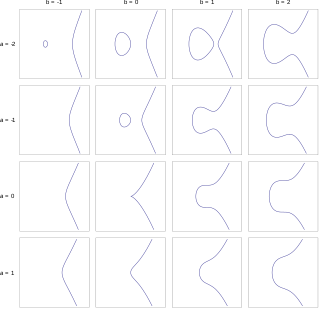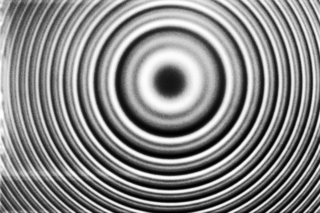
In mathematics, an elliptic curve is a smooth, projective, algebraic curve of genus one, on which there is a specified point O. An elliptic curve is defined over a field K and describes points in K2, the Cartesian product of K with itself. If the field's characteristic is different from 2 and 3, then the curve can be described as a plane algebraic curve which consists of solutions (x, y) for:

In optics, a Fabry–Pérot interferometer (FPI) or etalon is an optical cavity made from two parallel reflecting surfaces. Optical waves can pass through the optical cavity only when they are in resonance with it. It is named after Charles Fabry and Alfred Perot, who developed the instrument in 1899. Etalon is from the French étalon, meaning "measuring gauge" or "standard".

In probability theory and statistics, the beta distribution is a family of continuous probability distributions defined on the interval [0, 1] in terms of two positive parameters, denoted by alpha (α) and beta (β), that appear as exponents of the variable and its complement to 1, respectively, and control the shape of the distribution.
The laser diode rate equations model the electrical and optical performance of a laser diode. This system of ordinary differential equations relates the number or density of photons and charge carriers (electrons) in the device to the injection current and to device and material parameters such as carrier lifetime, photon lifetime, and the optical gain.
Cavity ring-down spectroscopy (CRDS) is a highly sensitive optical spectroscopic technique that enables measurement of absolute optical extinction by samples that scatter and absorb light. It has been widely used to study gaseous samples which absorb light at specific wavelengths, and in turn to determine mole fractions down to the parts per trillion level. The technique is also known as cavity ring-down laser absorption spectroscopy (CRLAS).

Ring lasers are composed of two beams of light of the same polarization traveling in opposite directions ("counter-rotating") in a closed loop.
Expected shortfall (ES) is a risk measure—a concept used in the field of financial risk measurement to evaluate the market risk or credit risk of a portfolio. The "expected shortfall at q% level" is the expected return on the portfolio in the worst of cases. ES is an alternative to value at risk that is more sensitive to the shape of the tail of the loss distribution.

An output coupler (OC) is the component of an optical resonator that allows the extraction of a portion of the light from the laser's intracavity beam. An output coupler most often consists of a partially reflective mirror, allowing a certain portion of the intracavity beam to transmit through. Other methods include the use of almost-totally reflective mirrors at each end of the cavity, emitting the beam either by focusing it into a small hole drilled in the center of one mirror, or by redirecting through the use of rotating mirrors, prisms, or other optical devices, causing the beam to bypass one of the end mirrors at a given time.
In physics, a quantum amplifier is an amplifier that uses quantum mechanical methods to amplify a signal; examples include the active elements of lasers and optical amplifiers.
Round-trip gain refers to the laser physics, and laser cavities. It is gain, integrated along a ray, which makes a round-trip in the cavity.
In laser physics, gain or amplification is a process where the medium transfers part of its energy to the emitted electromagnetic radiation, resulting in an increase in optical power. This is the basic principle of all lasers. Quantitatively, gain is a measure of the ability of a laser medium to increase optical power.
Tail value at risk (TVaR), also known as tail conditional expectation (TCE) or conditional tail expectation (CTE), is a risk measure associated with the more general value at risk. It quantifies the expected value of the loss given that an event outside a given probability level has occurred.
In electrochemistry, the Butler–Volmer equation, also known as Erdey-Grúz–Volmer equation, is one of the most fundamental relationships in electrochemical kinetics. It describes how the electrical current through an electrode depends on the voltage difference between the electrode and the bulk electrolyte for a simple, unimolecular redox reaction, considering that both a cathodic and an anodic reaction occur on the same electrode:
A superluminescent diode is an edge-emitting semiconductor light source based on superluminescence. It combines the high power and brightness of laser diodes with the low coherence of conventional light-emitting diodes. Its emission optical bandwidth, also described as full-width at half maximum, can range from 5 up to 750 nm.
Resonant-cavity-enhanced photo detectors are sensors of light or other electromagnetic radiation which use an optical cavity to more efficiently target specific wavelengths. With RCE photodetectors, the active device structure of a photodetectors is placed inside a Fabry–Pérot interferometer. The interferometer has two parallel surfaces between which selected wavelengths of light can be made to resonate, amplifying their optical field. Though the active device structure of the RCE detectors remains close to conventional photodetectors, the amplification effect of the optical cavity allows RCE photodetectors to be made thinner and therefore faster, while simultaneously increasing the quantum efficiency at the resonant wavelengths.
Laser linewidth is the spectral linewidth of a laser beam.
Incoherent broad band cavity enhanced absorption spectroscopy (IBBCEAS), sometimes called broadband cavity enhanced extinction spectroscopy (IBBCEES), measures the transmission of light intensity through a stable optical cavity consisting of high reflectance mirrors. The technique is realized using incoherent sources of radiation e.g. Xenon arc lamps, LEDs or supercontinuum (SC) lasers, hence the name.
In financial mathematics and stochastic optimization, the concept of risk measure is used to quantify the risk involved in a random outcome or risk position. Many risk measures have hitherto been proposed, each having certain characteristics. The entropic value at risk (EVaR) is a coherent risk measure introduced by Ahmadi-Javid, which is an upper bound for the value at risk (VaR) and the conditional value at risk (CVaR), obtained from the Chernoff inequality. The EVaR can also be represented by using the concept of relative entropy. Because of its connection with the VaR and the relative entropy, this risk measure is called "entropic value at risk". The EVaR was developed to tackle some computational inefficiencies of the CVaR. Getting inspiration from the dual representation of the EVaR, Ahmadi-Javid developed a wide class of coherent risk measures, called g-entropic risk measures. Both the CVaR and the EVaR are members of this class.
The modified lognormal power-law (MLP) function is a three parameter function that can be used to model data that have characteristics of a log-normal distribution and a power law behavior. It has been used to model the functional form of the initial mass function (IMF). Unlike the other functional forms of the IMF, the MLP is a single function with no joining conditions.
Laser theory of Fabry-Perot (FP) semiconductor lasers proves to be nonlinear, since the gain, the refractive index and the loss coefficient are the functions of energy flux. The nonlinear theory made it possible to explain a number of experiments some of which could not even be explained, much less modeled, on the basis of other theoretical models; this suggests that the nonlinear theory developed is a new paradigm of the laser theory.


























